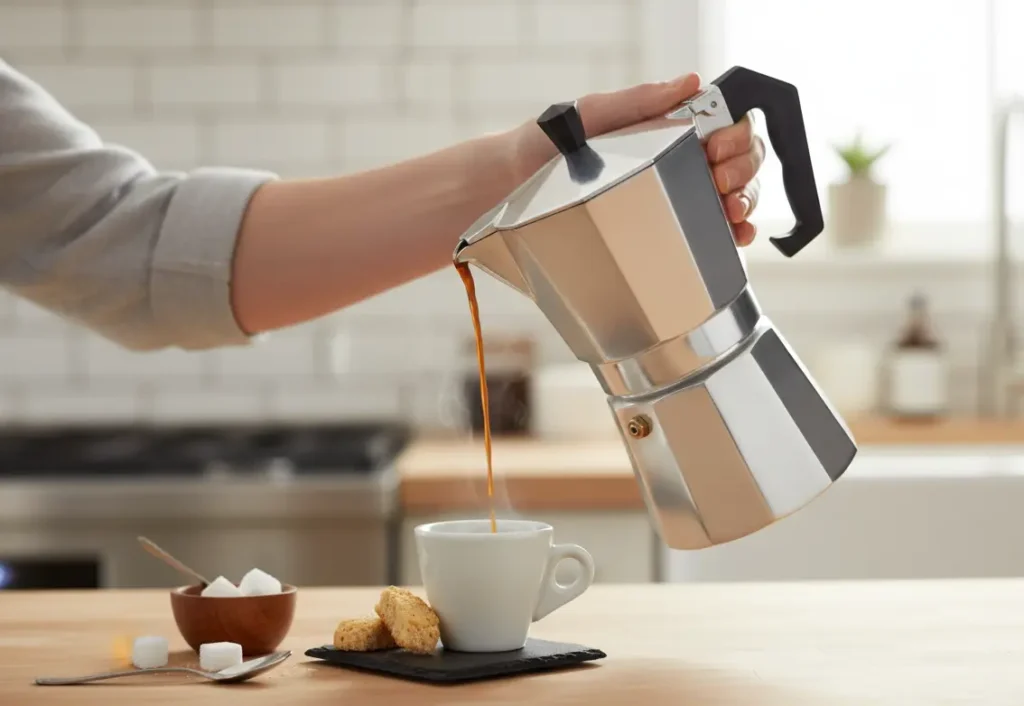If you love starting your day with a perfect cup of espresso, keeping your machine in top shape is key. Your espresso machine works hard to deliver rich, flavorful coffee, but without proper care, it can slow down or even break.
Imagine the frustration of a weak shot or a broken machine when you need your caffeine fix the most. You’ll discover simple, effective maintenance tips that save you time and money. By learning how to care for your espresso machine properly, you’ll enjoy better coffee and a longer-lasting appliance.
Keep reading—you won’t want to miss these easy steps to keep your espresso machine running like new.
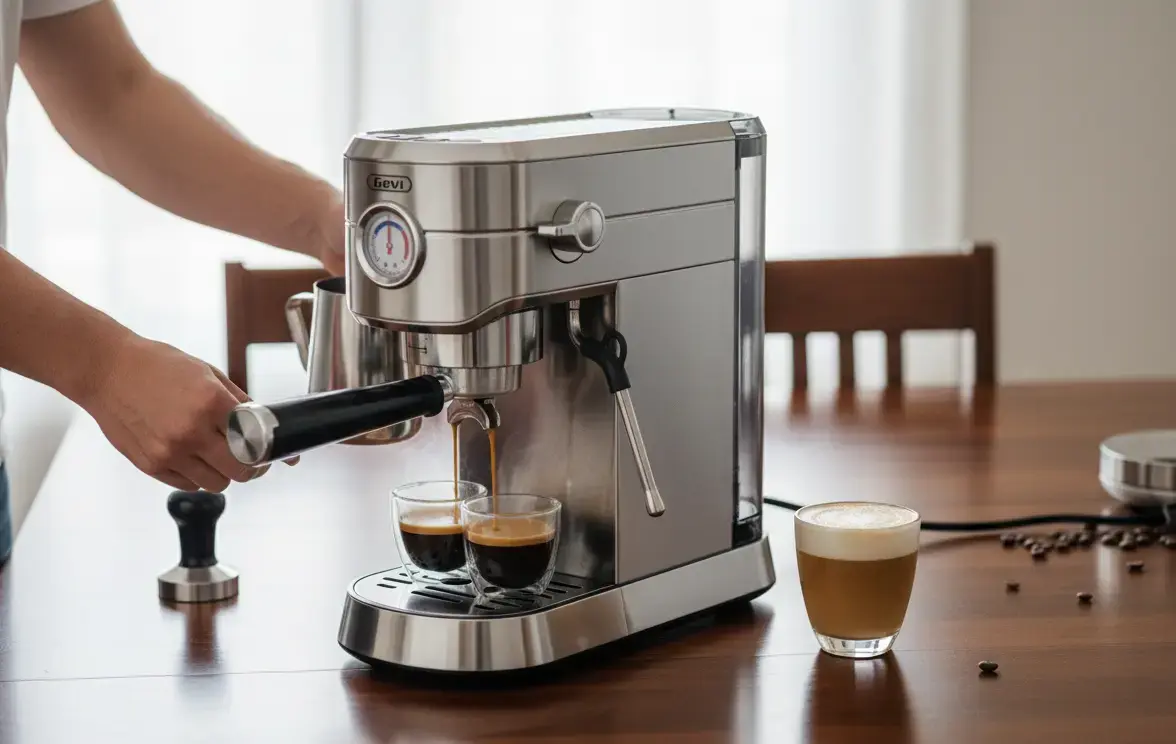
Daily Espresso Machine Cleaning Routine
Keeping an espresso machine clean every day helps it work well and last longer. A simple daily cleaning routine removes coffee oils, milk residues, and water deposits. This stops bad tastes from building up. It also protects the machine parts from damage. Spending a few minutes daily on cleaning can save money on repairs and keep your coffee tasting fresh and rich.
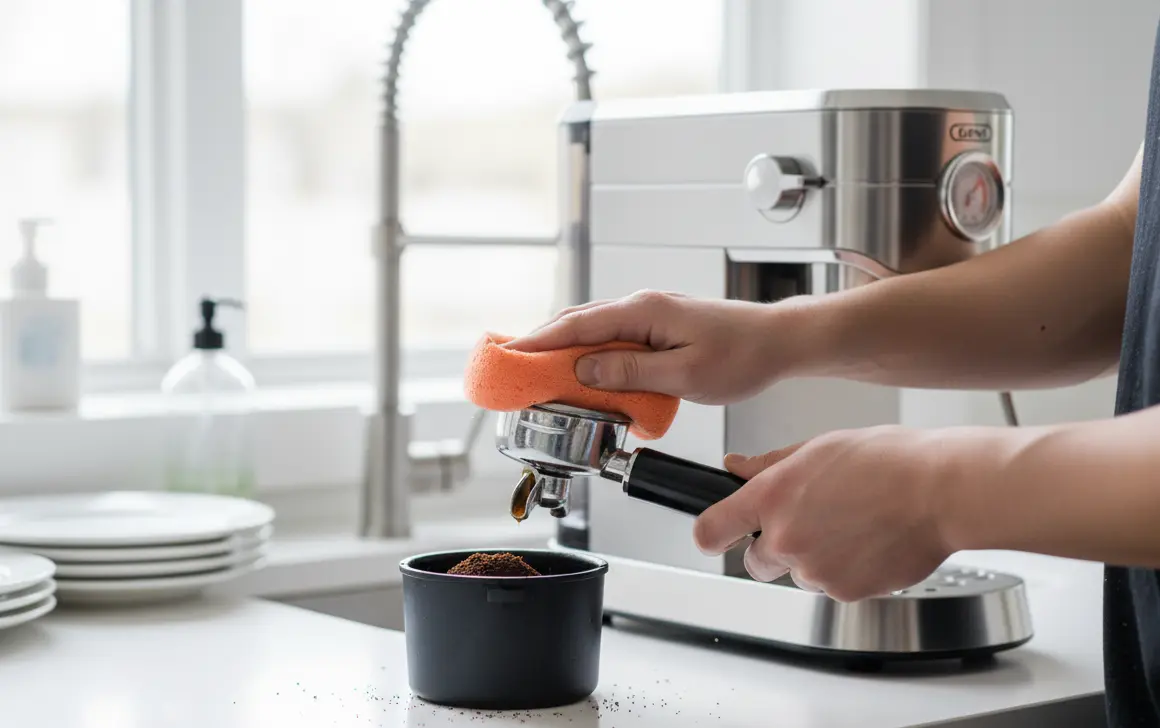
How To Clean Portafilter After Use: Step-by-Step Espresso Machine Care
The portafilter holds the coffee grounds during brewing. It collects oils and fine coffee particles that can build up quickly. Cleaning it every day keeps your espresso tasting pure and stops clogging. Follow these steps:
- Remove the portafilter from the machine after use.
- Discard used coffee grounds and rinse the basket with warm water.
- Use a clean cloth or sponge to wipe the portafilter’s edges and underside.
- Check the filter basket holes for blockages; use a small brush if needed.
- Dry the portafilter well before placing it back.
Consistent cleaning prevents old coffee residues from spoiling fresh shots. Here is a quick checklist:
| Task | Why It Matters | Tools Needed |
|---|---|---|
| Remove and discard grounds | Prevents stale coffee taste | Knock box or bin |
| Rinse basket and wipe portafilter | Removes oils and residues | Warm water, cloth, brush |
| Dry thoroughly | Stops rust and mold | Clean towel |
Steam Wand Maintenance
The steam wand froths milk and must stay clean to work well. Milk can dry inside the wand and cause clogs or bad smells. Clean it after each use to keep milk fresh and machines safe. Follow these steps:
- Wipe the wand with a damp cloth right after steaming milk.
- Steam some fresh water through the wand for a few seconds to clear milk inside.
- Use a small brush or pin to clean the tip holes if blocked.
- Soak the wand tip in warm water with mild detergent at the end of the day.
Regular cleaning avoids buildup and keeps milk fresh tasting. Here are common problems and solutions:
| Problem | Cause | Fix |
|---|---|---|
| Milk residue clog | Not wiping after use | Wipe and purge steam wand |
| Bad smell | Milk left inside wand | Soak and clean daily |
| Weak steam | Blocked holes | Clear with pin or brush |
Cleaning the Drip Tray: Essential Step in Espresso Machine Maintenance
The drip tray collects water, coffee spills, and milk drips. Letting it fill up can cause leaks or mold. Empty and clean the tray every day. This keeps the machine area tidy and safe. Follow these tips:
- Remove the drip tray carefully to avoid spills.
- Pour out the collected liquid into the sink.
- Wash the tray with warm water and soap.
- Dry thoroughly before replacing it in the machine.
- Check the tray grid for coffee grounds and clean it too.
Regular tray care stops smells and keeps counters clean. Use this quick daily checklist:
1. Remove tray 2. Empty liquid 3. Wash and rinse 4. Dry completely 5. Replace trayWeekly Maintenance Tasks
Regular care keeps an espresso machine working well and tasting great. Weekly maintenance tasks help remove coffee oils, limescale, and other buildup. This prevents damage and ensures every cup tastes fresh. Simple, routine cleaning saves money by avoiding repairs and extends the machine’s life. Focus on key areas like backflushing, descaling, and cleaning the group head to maintain top performance.
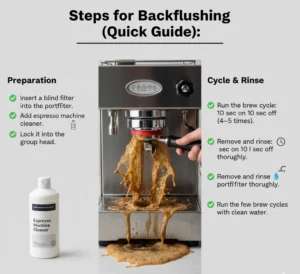
Backflushing The Machine
Backflushing cleans the espresso machine’s internal parts by forcing water and cleaner backward through the brew group. This removes coffee oils and debris that block water flow and affect flavor.
Steps for backflushing:
- Insert a blind filter (a filter without holes) into the portafilter.
- Add a small amount of espresso machine cleaner or detergent designed for backflushing.
- Lock the portafilter into the group head.
- Start the brew cycle for about 10 seconds, then stop for 10 seconds. Repeat 4-5 times.
- Remove the portafilter and rinse it thoroughly.
- Run several brew cycles with clean water to rinse out any cleaner residue.
Benefits of backflushing weekly:
- Prevents buildup inside the group head and valves.
- Improves espresso taste by removing old coffee oils.
- Maintains proper water pressure and flow.
- Reduces risk of machine breakdowns.
Use only cleaners made for espresso machines. Avoid harsh chemicals that can damage parts. Backflushing takes about 10 minutes and is vital for keeping your machine clean and efficient.
Espresso Machine Descaling Guide
Descaling removes mineral deposits like calcium and lime that build up inside the machine. Hard water causes these deposits. They reduce heating efficiency and block water flow.
Descaling steps for weekly care:
- Empty the water tank and add a descaling solution mixed with water, following product instructions.
- Run the brew cycle without coffee to let the solution pass through the system.
- Turn off the machine and let the solution sit for 15-20 minutes.
- Run several brew cycles with clean water to rinse all descaler from the machine.
Signs your machine needs descaling:
| Symptom | Effect |
|---|---|
| Slow water flow | Longer brewing times, weak espresso |
| Strange noises | Heating element struggles |
| Warning lights | Machine signals scale buildup |
Descaling keeps the heater working well and prevents costly repairs. Use descalers safe for espresso machines. Avoid vinegar, which can damage metal parts. Weekly descaling is key in areas with hard water.
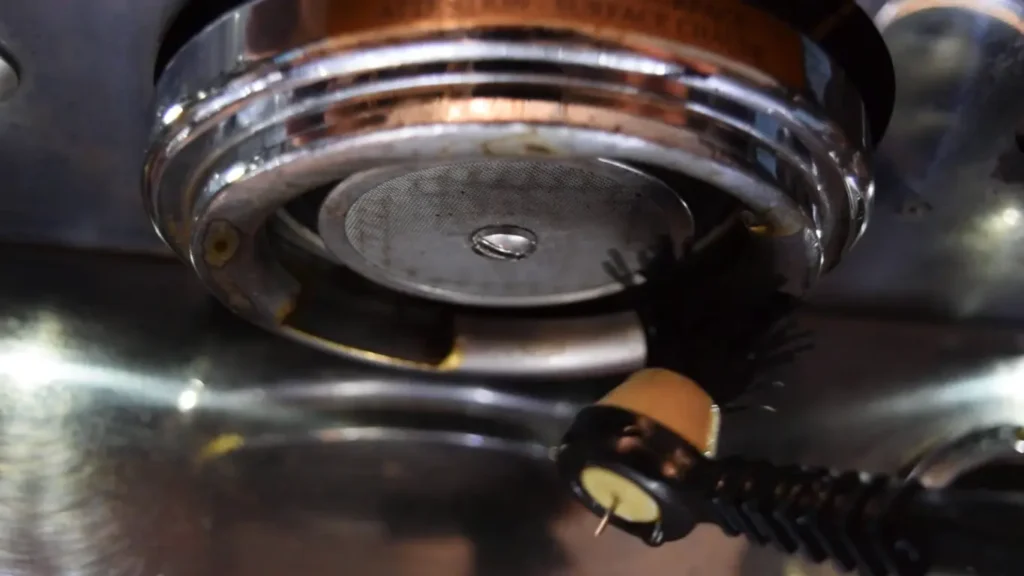
Cleaning The Group Head
The group head is where hot water meets coffee grounds. It collects oils and coffee particles during brewing. Cleaning it weekly stops old residue from spoiling the taste.
How to clean the group head:
- Remove the portafilter.
- Use a group head brush to scrub the gasket and screen.
- Run hot water through the group head for 10 seconds to rinse.
- Wipe the outside with a damp cloth.
- Inspect the gasket for wear and replace if needed.
Cleaning tips:
- Use a brush designed for espresso machines to reach tight spots.
- Don’t use abrasive tools that can damage the gasket.
- Clean the group head after each use, but do a deep clean weekly.
Keeping the group head clean ensures proper water flow and consistent espresso taste. It reduces clogging and extends gasket life. This small effort improves every shot you pull.
Monthly Deep Cleaning for Espresso Machines: Extend Lifespan and Taste Quality
Monthly deep cleaning is a vital step to keep your espresso machine working well. This cleaning helps remove coffee oils, mineral buildup, and dirt that regular daily cleaning cannot reach. A clean machine makes better coffee and lasts longer. Spend time each month to clean parts thoroughly and check for wear. Doing this keeps your espresso machine fresh and ready for every cup.
Removing And Soaking Parts
Start by taking off the removable parts of your espresso machine. These usually include the portafilter, basket, drip tray, and water tank. Removing these parts allows you to clean hidden coffee oils and residue that build up over time.
- Use warm water and a mild detergent to soak the parts.
- Soak for at least 30 minutes to loosen stuck coffee oils and grime.
- Use a soft brush or cloth to scrub gently after soaking.
Here is a simple table to guide the soaking process:
| Part | Soaking Time | Cleaning Tips |
|---|---|---|
| Portafilter and Basket | 30-45 minutes | Use a brush to clean small holes after soaking |
| Drip Tray | 15-30 minutes | Wipe with cloth and rinse well |
| Water Tank | 10-15 minutes | Use mild soap and rinse thoroughly |
After cleaning, dry the parts completely before putting them back. This step prevents mold or bacteria growth. Regular deep soaking removes stubborn buildup that spoils coffee taste.
Inspecting Seals And Gaskets
Seals and gaskets keep water inside the machine and prevent leaks. Checking them monthly helps avoid problems that affect your espresso quality. Look at these parts carefully for cracks, hardening, or tears.
- Remove the group head seal to check its condition.
- Check the portafilter gasket for firmness and flexibility.
- Replace any seal that looks worn or damaged.
Signs of worn seals include:
- Water leaking during brewing
- Pressure loss in the machine
- Unusual noises or dripping sounds
Use manufacturer-approved replacement seals to ensure a perfect fit. Installing new gaskets keeps water pressure steady. This step improves coffee extraction and machine safety. Regular inspection prevents costly repairs and keeps your espresso tasting great.
Replacing Water Filters
Water filters remove impurities and minerals from tap water. These minerals can build up inside your espresso machine, causing damage. Changing the water filter every month ensures cleaner water and better coffee flavor.
Steps to replace your water filter:
- Turn off and unplug the machine.
- Remove the old filter from the water tank or filter holder.
- Rinse the new filter under cold water for a few seconds.
- Insert the new filter into the machine securely.
- Fill the water tank with fresh water.
Here is a quick comparison of filter benefits and risks of not replacing:
| Benefit of Replacing Filter | Risk of Not Replacing |
|---|---|
| Reduces scale buildup | Mineral deposits damage machine parts |
| Improves water taste | Bitter or off-flavors in coffee |
| Extends machine life | More frequent repairs needed |
Replacing water filters regularly protects your espresso machine and improves every cup’s flavor. A small monthly step with a big impact.
Troubleshooting Common Issues
Espresso machines need regular care to work well. Sometimes, problems occur that affect the coffee quality or machine performance. Troubleshooting common issues helps fix these problems fast. Understanding what causes issues like low pressure, temperature swings, or strange sounds keeps your machine running smoothly. This section explains how to identify and solve typical espresso machine troubles.
Low Pressure Problems
Low pressure in an espresso machine stops the water from passing through the coffee grounds correctly. This leads to weak coffee with poor flavor and crema. Several reasons cause low pressure, and checking them step-by-step helps.
- Clogged Group Head: Coffee oils and grounds build up, blocking water flow.
- Dirty or Worn Portafilter: Poor seal or damage reduces pressure.
- Faulty Pump: The pump may lose strength or fail.
- Blocked Water Lines: Scale or debris can clog internal pipes.
Try these fixes to restore pressure:
- Clean the group head with a brush and backflush using espresso machine cleaner.
- Check the portafilter gasket and replace it if cracked or worn.
- Test the pump pressure with a gauge; replace the pump if below manufacturer specs.
- Descale the machine regularly to prevent mineral build-up.
| Cause | Effect | Solution |
|---|---|---|
| Clogged Group Head | Water flow blocked, weak espresso | Clean with brush and backflush |
| Worn Portafilter Gasket | Poor seal, pressure loss | Replace gasket |
| Faulty Pump | Low or no pressure | Test and replace pump |
| Blocked Water Lines | Reduced water flow | Descale machine regularly |
Inconsistent Temperature
Espresso needs water at a steady temperature, usually between 90°C and 96°C. Temperature swings cause bitter or sour coffee. Inconsistent heat comes from several issues inside the machine.
- Faulty Thermostat: It controls the heating element and may fail or misread.
- Heating Element Problems: Scale or wear can reduce heating power.
- Poor Temperature Sensor Connection: Loose wires affect readings.
- Incorrect Machine Settings: Factory settings may be off or changed accidentally.
Steps to fix temperature problems:
- Measure water temperature with a thermometer during brewing.
- Inspect and replace the thermostat if the temperature varies widely.
- Check heating element for scale and clean or replace it.
- Ensure sensor wiring is secure and free from damage.
- Reset machine settings to default or adjust temperature controls carefully.
| Issue | Symptom | Action |
|---|---|---|
| Faulty Thermostat | Temperature spikes or drops | Test and replace thermostat |
| Heating Element Scale | Slow or no heating | Clean or replace element |
| Loose Sensor Wiring | Incorrect temperature readings | Secure wiring |
| Wrong Settings | Inconsistent brew temperature | Reset or adjust settings |
Unusual Noises
Strange sounds from an espresso machine signal internal problems. Listening closely helps catch issues early and avoid damage. Common unusual noises include grinding, hissing, or knocking sounds.
- Grinding Noise: May come from a failing pump or motor parts.
- Hissing or Whistling: Steam leaks or blocked valves cause this.
- Knocking or Banging: Water hammer effect or loose parts are likely causes.
- Vibrations: Machine may be unlevel or have worn mounts.
How to troubleshoot noisy espresso machines:
- Turn off the machine and unplug it before inspection.
- Check for loose screws, panels, or components and tighten them.
- Inspect the pump and motor for signs of wear or damage.
- Look for steam leaks around the group head and valves.
- Level the machine on a stable surface to reduce vibrations.
| Noise Type | Possible Cause | Fix |
|---|---|---|
| Grinding | Worn pump or motor parts | Inspect and replace parts |
| Hissing/Whistling | Steam leaks, blocked valves | Check seals and clean valves |
| Knocking/Banging | Water hammer, loose parts | Tighten parts, install water hammer arrestor |
| Vibrations | Unlevel machine, worn mounts | Level machine, replace mounts |
Pro Tips for Espresso Machine Longevity
Keeping an espresso machine in top shape helps it work longer and brew better coffee. Simple care steps can stop damage and avoid costly repairs. Following easy tips for longevity ensures every cup tastes great and the machine runs smoothly for years. Focus on water quality, storage, and regular check-ups to protect the investment.
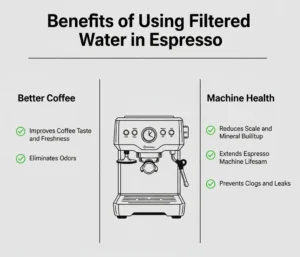
Using Filtered Water
Using filtered water is one of the easiest ways to protect an espresso machine. Tap water often contains minerals and impurities that cause buildup inside the machine. This buildup can block pipes, reduce heating efficiency, and damage parts over time.
Benefits of filtered water include:
- Less scale and mineral deposits
- Cleaner taste in every cup
- Longer life for internal components
- Reduced risk of clogs and leaks
To choose the right water filter, consider the following:
| Filter Type | Removes | Best For |
|---|---|---|
| Carbon filter | Chlorine, odors | Improving taste |
| Reverse osmosis | Minerals, salts | Hard water areas |
| Water softener | Calcium, magnesium | Preventing scale |
Tip: Change filters regularly, following the manufacturer’s guide. Check water hardness levels and adjust filtration if needed. Using clean water lowers maintenance needs and keeps coffee flavor pure.
Proper Storage Practices
Storing the espresso machine correctly protects it from dust, moisture, and damage. After use, always clean and dry the machine before storage. Moisture left inside can cause mold and rust, harming parts and taste.
Key storage tips include:
- Wipe the machine dry after each use
- Keep it in a cool, dry place away from sunlight
- Cover the machine with a dust cloth or dedicated cover
- Store removable parts separately if possible
For machines used less often, run a cleaning cycle before storage. Remove water from the tank and drip tray to avoid standing water. If storing for a long time, empty internal pipes using a descaling solution.
Proper storage also means avoiding crowded or unstable surfaces. Place the machine on a flat, sturdy counter to prevent falls or bumps. This simple care prevents cracks and electrical issues.
Regular Professional Servicing
Professional servicing keeps an espresso machine running smoothly. Experts clean hard-to-reach parts and check for wear or damage. This service helps prevent breakdowns and extends machine life.
Professional maintenance usually covers:
- Deep cleaning of internal components
- Descaling to remove mineral buildup
- Checking and replacing worn gaskets and seals
- Testing electrical and heating systems
- Calibrating pressure and temperature settings
Schedule professional servicing every 6 to 12 months, depending on use. Heavy daily use may require more frequent checks. Keep a maintenance log to track service dates and work done.
Regular inspections catch small problems before they grow. This approach saves money and avoids machine downtime. Trust trained technicians for thorough care and advice on machine upkeep.
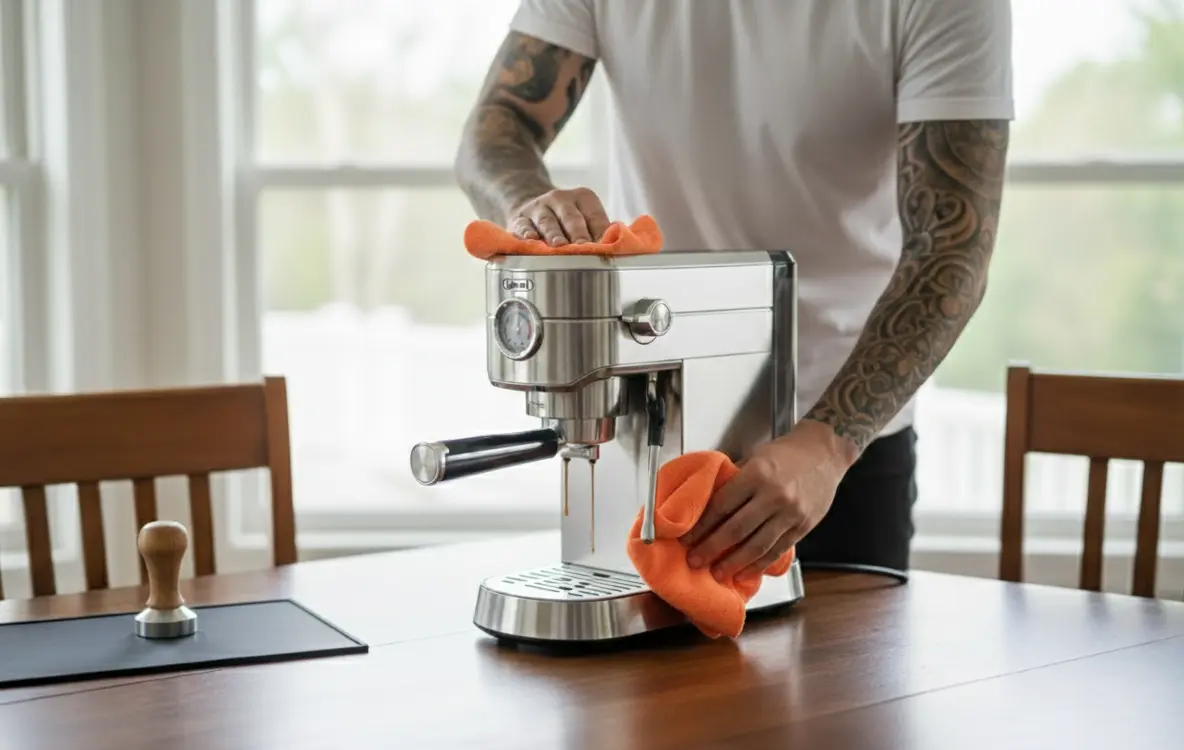
Conclusion
Regular cleaning keeps your espresso machine working well. Removing old coffee oils stops bad tastes. Check the water filter often for fresh water. Clean the steam wand after every use. Descaling prevents clogs and extends your machine’s life. Small steps save you time and money later.
Enjoy fresh, tasty espresso every day. A little care makes a big difference. Keep your machine ready for the perfect cup. Simple habits lead to better coffee at home.
Espresso Machine Maintenance FAQs
How Often Should I Clean My Espresso Machine?
Clean your espresso machine weekly to prevent buildup and keep coffee tasting fresh.
What Is The Best Way To Descale An Espresso Machine?
Use a commercial descaling solution and follow the manufacturer's instructions carefully.
Can I Use Vinegar To Clean My Espresso Machine?
Vinegar can harm some machines; use only if the manual approves it.
How Do I Maintain The Steam Wand On My Espresso Machine?
Purge and wipe the steam wand after each use to avoid milk residue.
What Causes Bitter Taste In Espresso From A Dirty Machine?
Old coffee oils and mineral buildup cause bitterness and must be cleaned out.

Hi, I’m Joshua Miller, a U.S.-based food lover, review writer, and Co-founder of KitchenWink.com. I hold a Bachelor of Science in Food Science and Culinary Technology, and for over five years I’ve been testing kitchen gadgets like air fryers, blenders, and other cooking tools.
I’m also a home cook, so every product I review is tried in real kitchens—not just in theory. My reviews are based on real results, simple fixes, and tips that anyone can use. With both formal training and hands-on testing, I make sure my advice is clear, honest, and practical.
My goal is simple: to help home cooks choose the right tools and make cooking easier every day.


